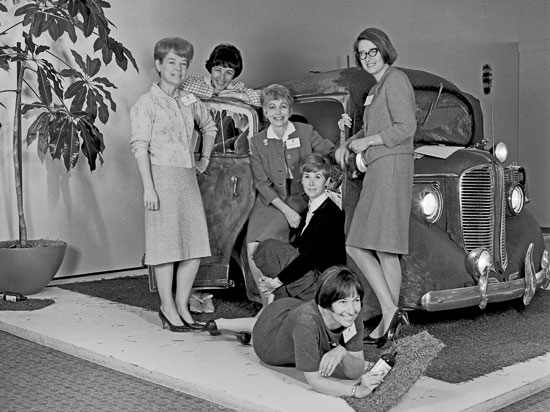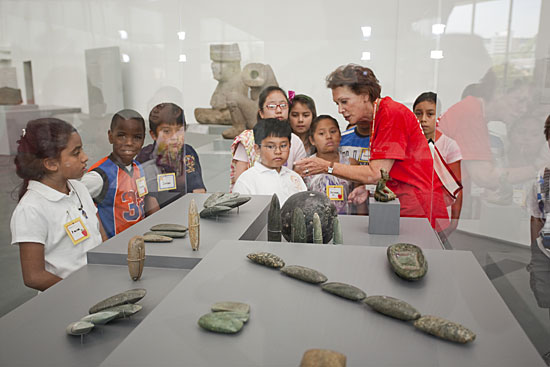LACMA docents mark 50 artful years
May 8, 2012

Terry Bell, second from left, and fellow docents defended Kienholz's "Back Seat Dodge '38" in LACMA's early years.
Terry Bell was a 34-year-old homemaker with two children in Westwood when art changed her life.
“It was the early ‘60s, and I had a good friend who did fundraising for the museum,” she remembers. “One day she said, ‘You’re a disgrace! You’re a college graduate and you don’t know anything about painting or sculpture.’ ”
At her friend’s insistence, she signed up for a then-new program to train docents at the Los Angeles Museum of History, Science and Art in Exposition Park, which at the time housed the county’s art collection. Now, 50 years later, she is an avid art collector, a Los Angeles County Museum of Art life trustee and a founding member of one of the largest docent organizations in the nation. She has exposed thousands of visitors to museum treasures, recorded acoustic guides for major exhibitions and worked against the censorship of controversial and important artworks.
And she traces it all to that decision a half-century ago to volunteer as a LACMA docent..
“It is just so rewarding,” says Bell, who this week is among the hundreds of honorees celebrating the golden anniversary of LACMA’s Docent Council. “Not only in terms of yourself, but in what you can give back to the community.”
Some 521 men and women belong to the Docent Council, a volunteer juggernaut whose members have led more than 2 million children and adults through the museum since it became an official entity in 1962.
More than a million Southern California schoolchildren have been led on field trips by LACMA docents; so have generations of adult visitors to the museum’s many exhibitions.
“We are definitely in the front lines,” says Judith Tuch, who chairs the council. “We provide the personal connection between the students and adults who come to the museum and the art they see. For many, it’s the first time they’ve ever been in a museum. For some, unfortunately, it may be the only time they’ll be in a museum.
“We encourage them to understand that this is a county museum, and that this is their place.”
The council grew from a small group of volunteers who explained art during the 1950s at what is now the Natural History Museum. Though visitors at that Exposition Park site mostly came to see dinosaurs and fossils, the county also had quietly been amassing fine art since the 1920s. Members of the Junior League, the Volunteer League of the San Fernando Valley and other local organizations offered informal tours of the gifts from such early donors as William Preston Harrison, Paul Rodman Mabury and William Randolph Hearst.
In 1961, amid planning for a separate Los Angeles County Museum of Art on Wilshire Boulevard, the groups joined forces to create a formal docent training program. Fifty-three women took the special classes in art history and elementary education.
After a provisional year, the Docent Council was officially formed, chaired by Glenn Cooper, a Junior Leaguer who later became a well-known arts patron in Sun Valley. Their goal: To train 200 docents in time for the official opening of LACMA in 1965.
The docents were key almost from the moment the new museum opened. In 1966, for instance, they rose to defend Edward Kienholz’s still-controversial “Back Seat Dodge ’38.” The piece, which depicts a beer-soaked encounter in a parked car, is so sexually charged that members of the then-Board of Supervisors denounced it as pornographic.
“I had met Ed Kienholz and talked to him about the exhibition, and I thought it was terrific,” Bell remembers.
 Eventually, the Supervisors decided the piece could be seen, “but the door to the car couldn’t be open unless a docent was there to explain it,” Bell says, recalling that at one point, she had to tour a group of clergy that included her own rabbi—whom she had to shush with the admonition that she listened to him every week, so he should do her the courtesy of returning the favor.
Eventually, the Supervisors decided the piece could be seen, “but the door to the car couldn’t be open unless a docent was there to explain it,” Bell says, recalling that at one point, she had to tour a group of clergy that included her own rabbi—whom she had to shush with the admonition that she listened to him every week, so he should do her the courtesy of returning the favor.
The piece—like later Kienholz exhibitions that Bell also guided—became a sensation and visitors mobbed the museum. “Five or six of us guided tours every 20 minutes,” Bell remembers, “almost around the clock.”
Since then, the council has grown along with the county in diversity and sophistication. Some 25 members are men and docents of all races, creeds, ages and backgrounds lead tours in multiple languages.
Now overseen by the museum’s Education Department, the group has a training regimen that includes extensive coursework in art history and touring techniques and a 2-year provisional period. No member can tour adults without spending at least 5 years doing school tours.
“We have several attorneys in the current [provisional] class,” says Patsy Palmer, a child psychotherapist and longtime LACMA volunteer who now trains incoming docents. “One man in my group is a retired doctor.” All the new docents, she says, “are highly qualified and uniquely skilled.”
“We’ve come so far,” agrees Bell, who says she can’t wait to see how visitors respond to “Levitated Mass” and other upcoming attractions. “We’re really in a marvelous place.”

LACMA docent Patsy Palmer has shown the museum to legions of children. The Docent Council turns 50 this week.
Posted 5/2/12














 405 bridge work causes a stink
405 bridge work causes a stink